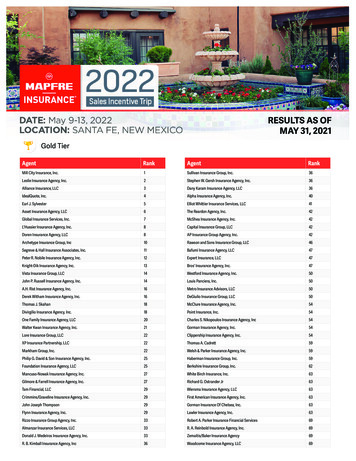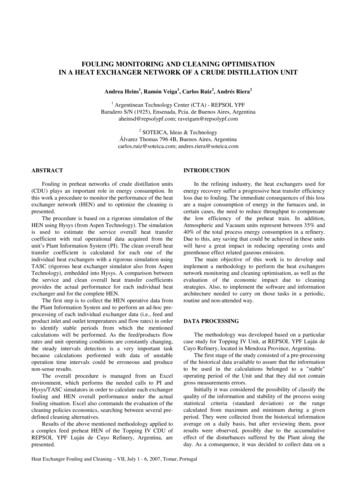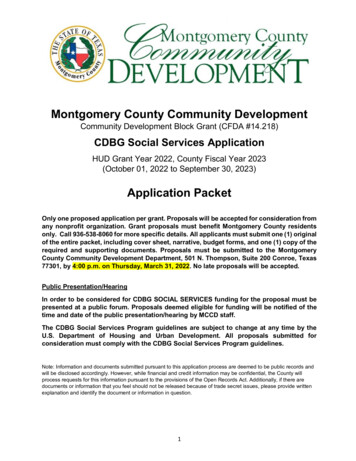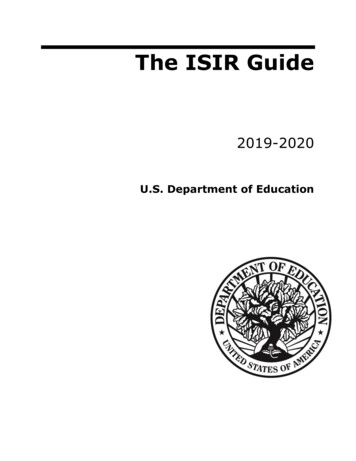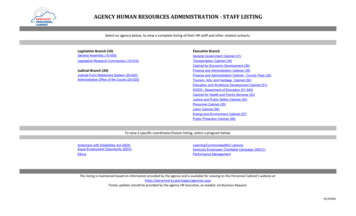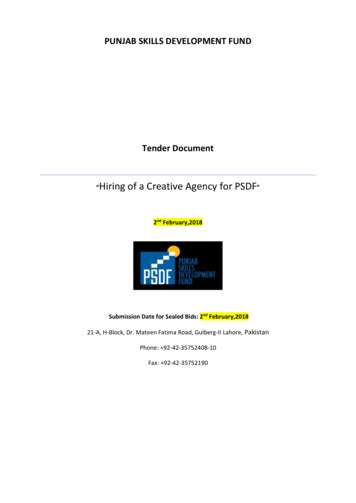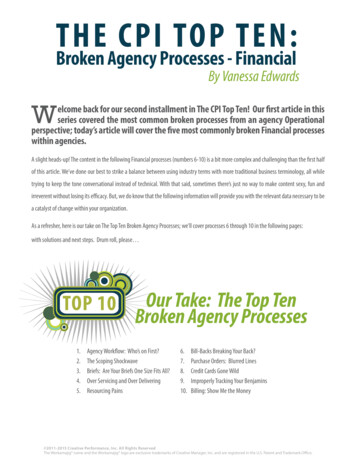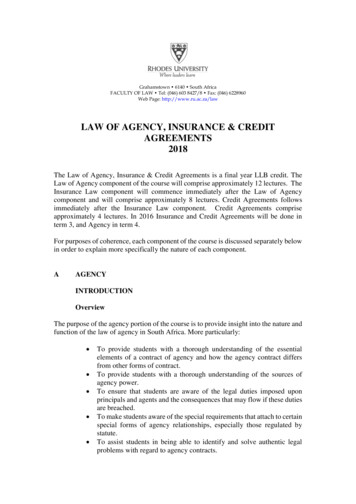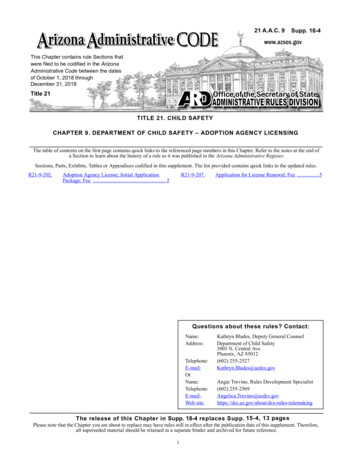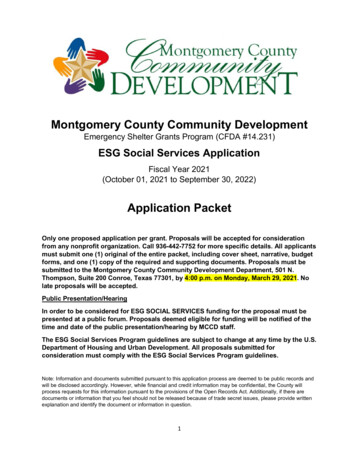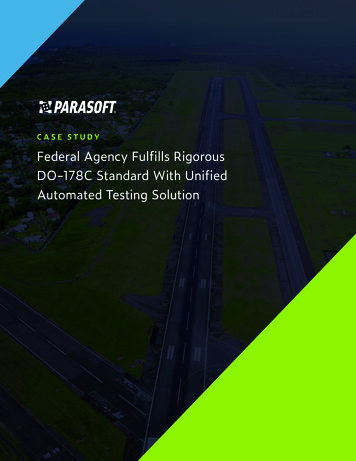
Transcription
Case StudyFederal Agency Fulfills Rigorous DO-178C Standard With Unified Automated Testing SolutionCASE STUDYFederal Agency Fulfills RigorousDO-178C Standard With UnifiedAutomated Testing Solution1
OVERVIEWA federal agency develops an air navigation aid system for the aviationindustry to augment the global positioning system (GPS) with the goal ofimproving its accuracy and availability. On its own, GPS isn’t intended forexact location measurement. The implementation of the air navigationaid system allows for precise approaches such as take off and landing.The system uses ground-based reference stations to broadcast correctionmessages to improve the accuracy of GPS.HOW THE AIR NAVIGATION SYSTEM WORKSAt a high level, here’s how the air navigation aid system works. The signalsfrom GPS satellites are received across numerous widely-spaced groundreference station sites. The ground reference station locations are knownfor high precision and can detect errors in received GPS signals.The GPS information collected by the ground reference station sites istransmitted to a master ground reference station. This master groundstation generates an enhanced and augmented GPS user message everysecond with information enabling the augmented GPS receivers or airnavigation system to remove errors in the GPS signal. The system relies onthis real time update on a continuous basis to increase precision of GPS foraviation navigation across North America.REDUCEDDECREASEDINCREASEDTime to Test CodeLabor & CostsProductivity2
Case StudyFederal Agency Fulfills Rigorous DO-178C Standard With Unified Automated Testing SolutionTHE CHALLENGEPart of the air navigation aid system relies on embedded systemsdeveloped with C programming language and in compliance with RTCADO-178C. Some parts of the system are developed to design assurancelevel (DAL) B and other parts to DAL D. In many cases, the validationand verification requirements include rigorous testing and measurementof code coverage achieved during testing. DO-178C requires a suitablelevel of coverage. Recording test results and coverage are importantdevelopment artifacts.The federal agency and their primary contractor were struggling witha legacy code coverage system that was incompatible with the modernrequirements of the air navigation aid system and the regulationcompliance they required. In addition, the lack of integration between thevarious development and testing tools was causing delays and increasedeffort to achieve compliance.THE APPROACHThe federal agency needed to find an updated moderntesting and code coverage measurement solution thatwould work with the Wind River VxWorks operatingsystem and within the Wind River Workbench IDE.The primary contractor for the air navigation aid systemwas already a Parasoft C/C test user. The federalagency adopted the product from this relationship. Thissatisfied their need for a modern static analysis solutionand solved their unit testing and code coverage issues.The unified solution provided by Parasoft was anattractive alternative to their legacy tools.THE SOLUTIONThe development group for the air navigation aid system chose ParasoftC/C test to perform the following:» Statement coverage» Branch and MC/DC code coverage» Static analysis» Unit testing3
Case StudyFederal Agency Fulfills Rigorous DO-178C Standard With Unified Automated Testing Solution“Parasoft C/C test gave us all the software test automationsolutions we needed in one package to help us satisfycompliance to DO-178C for a very large code base.”—Brenton Graefe, software engineerThe group uses the unified solution at the desktop level within their IDE,where engineers can do the following:» Check out code and make edits.» Run static analysis.» Address any coding standard deviations.They also create and run unit test cases, validate functionality, and collectcode coverage at the same time. When code passes validation, all artifactsare checked into their repository.The development group uses Parasoft DTP to host test configurationsand provide project-wide status from testing, coverage, and codingstandard compliance. In this case, they follow an augmented MISRAC-based standard.Moving to Parasoft C/C test provides an integrated and unified solutionthat helps the federal agency comply with the rigorous DO-178C standard.The level of testautomation in the projecthas increased dramaticallysince adopting theParasoft solution. As aresult, there's a reductionin the amount of time ittakes to test code. There'salso a decrease in laborand costs.The development group of the air navigation aid system improvedproductivity thanks to:» Host-based and embedded target-based automation.» Code coverage analysis.» Automated enforcement of safety-critical coding standards with staticanalysis.4
Case StudyFederal Agency Fulfills Rigorous DO-178C Standard With Unified Automated Testing SolutionTHE RESULTSThe Parasoft automated software testing solution provides macro andmicro levels of detail about the testing status and results of the airnavigation aid system than previously possible. The detailed code coveragefrom Parasoft C/C test gives the group the insight they were missingwith their legacy tool.Using Parasoft DTP, the group can view the entire software developmentlife cycle process and determine at a high level what they need outof testing. They can also zoom into testing details. Below are generalexamples of DTP reports.Parasoft DTP aggregates andanalyzes results for all tests.The level of test automation in the project has increased dramatically sinceadopting the Parasoft solution. As a result, there’s a reduction in the amountof time it takes to test code. There’s also a decrease in labor and costs.5
TAKE THE NEXT STEPDiscover the value of using a unified C/C testing tool and learn howyour embedded software development team can maximize testing ROI.Download the whitepaper.ABOUT PARASOFTParasoft helps organizations continuously deliver quality softwarewith its market-proven, integrated suite of automated software testingtools. Supporting the embedded, enterprise, and IoT markets, Parasoft’stechnologies reduce the time, effort, and cost of delivering secure, reliable,and compliant software by integrating everything from deep code analysisand unit testing to web UI and API testing, plus service virtualizationand complete code coverage, into the delivery pipeline. Bringing all thistogether, Parasoft’s award-winning reporting and analytics dashboarddelivers a centralized view of quality enabling organizations to deliverwith confidence and succeed in today’s most strategic ecosystems anddevelopment initiatives—security, safety-critical, Agile, DevOps, andcontinuous testing.6
DO-178C. Some parts of the system are developed to design assurance level (DAL) B and other parts to DAL D. In many cases, the validation and verification requirements include rigorous testing and measurement of code coverage achieved during testing. DO-178C requires a suitable level of coverage. Recording test results and coverage are important
